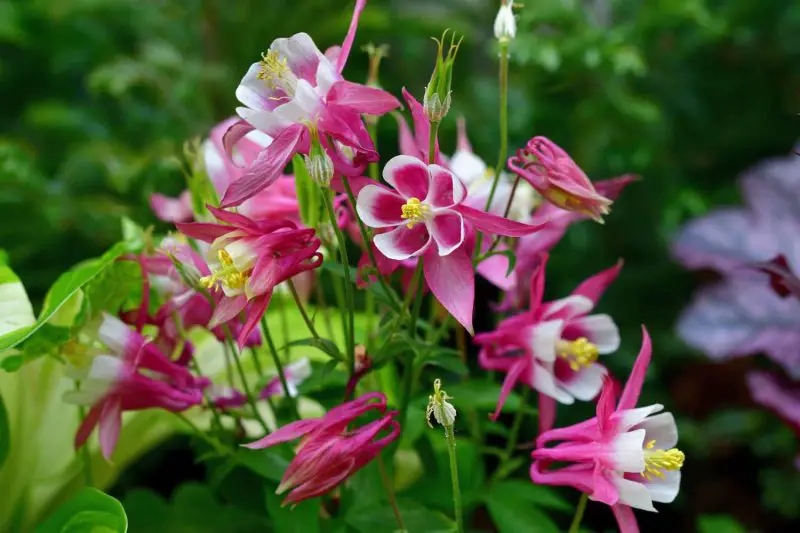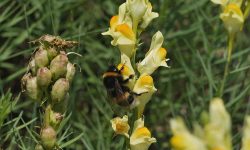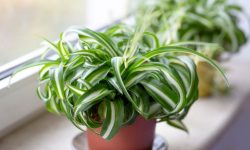Columbine is a graceful flower known for its unique shape and vibrant colors. Blooming mainly in spring and early summer, it brings a delicate yet striking charm to gardens. Many gardeners love columbine not only for its low maintenance but also for its ability to attract hummingbirds, butterflies, and bees. With such a mix of vivid hues and resilient growth, columbine easily becomes a natural highlight in any outdoor space.
Understanding how long columbine bloom lasts allows you to plan your garden more effectively. The bloom duration varies depending on climate and care practices. This guide will help you explore the full blooming cycle, learn practical ways to extend the display, and keep your garden filled with lasting beauty.
Understanding Columbine Blooming Cycle

Columbine flowers have a distinctive blooming cycle that sets them apart from many other perennials. They usually begin flowering in mid to late spring when the weather is mild. The blooms open gradually, creating a layered display of colors that can last for several weeks. Each flower has a delicate spurred shape, which adds elegance and depth to the garden. Gardeners often find this early bloom especially valuable since it bridges the gap between spring bulbs and summer perennials. Knowing when columbine begins its bloom is the first step toward enjoying its full potential.
The length of the blooming season depends on both the variety and the environment. In most cases, columbine continues flowering for about four to six weeks. Individual blooms usually last one to two weeks before fading. However, new buds appear in sequence, allowing the plant to maintain an ongoing show of color. This staggered flowering pattern ensures the plant remains attractive even when some blossoms are fading. With proper care, columbine may extend its blooming window, providing continuous interest in the garden.
Another feature of the columbine blooming cycle is its ability to self-seed. When flowers are left to mature, they form seed pods that eventually scatter around the garden. These seeds often germinate the following year, creating new plants that bloom in the next season. This natural cycle allows columbine to return reliably, offering fresh blooms each spring. Understanding this rhythm helps gardeners decide when to deadhead or let seeds develop. By working with the natural cycle, you can enjoy both long-lasting blooms and new generations of plants.
How Long Does Columbine Bloom in Different Climates
Blooming in Cool Regions
Columbine thrives in cooler climates where spring arrives slowly and summer temperatures stay mild. In these regions, the blooming season usually begins in late spring and may last well into early summer. The lower heat levels allow the flowers to stay fresh for longer. Gardeners often enjoy a steady display for up to six weeks, sometimes more if conditions are stable. Cool nights help preserve the petals and extend the life of each individual bloom.
Moist soil and moderate temperatures create the perfect balance for columbine in cool regions. Plants are less likely to suffer from stress, which means buds open more gradually. This slower pace ensures a prolonged season with blooms appearing in sequence. With proper care, including deadheading and light feeding, columbine in cool climates can outperform many other perennials. The flowers remain bright, and the plant continues to attract pollinators throughout the season. For gardeners in northern zones, columbine becomes a reliable highlight each spring.
Blooming in Warm Regions
Columbine faces different challenges in warm climates, where heat arrives quickly and lingers. In these regions, blooming usually starts earlier in spring and ends sooner as summer heat intensifies. The flowers often last for only three to four weeks before fading. High temperatures can shorten the lifespan of each blossom, reducing the overall display. Gardeners may notice petals wilting faster compared to plants in cooler areas.
To extend blooming in warm climates, providing shade during the hottest part of the day is essential. Consistent watering also helps reduce stress and prolong flowering. Mulching around the base keeps the soil cooler, which supports root health and encourages more buds. While the blooming period is shorter, thoughtful care can add extra weeks of color. In some cases, a second lighter bloom may appear in late summer if conditions improve. Warm region gardeners should plan around this shorter cycle to maintain continuous garden beauty.
Effects of Altitude and Sunlight
Altitude and sunlight also play major roles in how long columbine will bloom. At higher elevations, temperatures are cooler and nights are longer, which slows the blooming process. This often results in flowers lasting longer and showing more vibrant colors. The crisp mountain air can extend the display by several weeks compared to lowland gardens. Columbine has evolved to thrive in alpine settings, making it naturally suited to these conditions.
Sunlight exposure further influences the bloom cycle. Columbine prefers partial shade rather than intense full sun, especially in hot areas. Too much direct light can shorten the blooming window by stressing the plant. With morning sun and afternoon shade, flowers open at a steady pace and remain fresh longer. Balanced light also encourages more buds to form, creating a staggered display. Gardeners who adjust placement and exposure can directly impact bloom duration. By combining the right sunlight and altitude, columbine becomes a long-lasting feature in the landscape.
Factors That Affect Columbine Bloom Duration
Soil Quality and Fertility
Soil quality has a direct impact on how long columbine flowers last. These plants prefer well-drained soil that is rich in organic matter. A balanced environment supports steady growth and continuous bud production. When the soil is too poor, plants may produce fewer blooms that fade quickly. On the other hand, overly rich soil can encourage excess foliage at the expense of flowers. Striking the right balance ensures both healthy leaves and long-lasting blooms.
Fertility also plays an important role in bloom duration. A slow-release fertilizer applied in early spring provides nutrients that encourage buds to form. However, too much nitrogen should be avoided, as it promotes leaf growth over flowers. Adding compost or organic mulch improves soil structure while feeding the plant naturally. Healthy soil not only extends the blooming season but also strengthens roots for the following year. With proper preparation, columbine can deliver a vibrant display season after season.
Watering Practices
Consistent watering is essential for columbine to reach its full blooming potential. These plants thrive in soil that is evenly moist but not waterlogged. Too little water causes stress, leading to shorter flowering periods and smaller blossoms. On the other hand, excessive watering can damage roots and reduce bloom quality. Striking a balance allows the plant to use its energy efficiently. Healthy hydration supports both the flowers and the foliage, ensuring a lasting display.
Watering practices should be adjusted based on climate and season. In cooler regions, natural rainfall may be sufficient, while warmer areas require regular attention. Deep watering once or twice a week encourages strong root growth. Mulching around the base helps retain moisture, especially during hot spells. By keeping soil conditions stable, gardeners can extend the bloom window significantly. Proper watering not only keeps flowers vibrant but also ensures columbine remains a resilient part of the garden.
Impact of Temperature Changes
Temperature swings influence how long columbine stays in bloom. Cool, steady weather allows flowers to remain open longer and buds to develop gradually. Sudden heat waves can shorten the bloom time, causing petals to wilt and fall early. Similarly, unexpected frosts may damage buds before they fully open. These fluctuations can reduce the overall length of the flowering season. Stable conditions are therefore ideal for achieving the longest possible bloom.
Gardeners can help moderate the effects of temperature changes through placement and care. Planting columbine in areas with morning sun and afternoon shade reduces stress from heat. Mulching insulates roots, helping regulate soil temperature. In cooler regions, protection from late frosts preserves tender buds. Each adjustment makes a difference in how well the plant withstands sudden shifts. With thoughtful planning, columbine can maintain its charm even when the weather is less predictable. This ensures the garden remains colorful and balanced for weeks.
Simple Tips to Extend Columbine Bloom Time
Deadheading for Longer Blooms
Deadheading is one of the simplest and most effective ways to extend the columbine bloom season. By removing faded flowers, the plant redirects its energy from seed production to creating new buds. This process encourages continuous flowering throughout spring and into early summer. Without deadheading, columbine quickly moves into seed formation, which shortens the colorful display. Regular attention keeps the plant fresh and vibrant.
The process itself is easy and does not require special tools. Simply snip off the spent flowers just above a healthy set of leaves. Doing this every few days helps maintain the plant’s energy for blooming. Gardeners often notice that new buds form within weeks, prolonging the season. Deadheading also improves the plant’s appearance by removing faded petals. With consistent practice, columbine can deliver weeks of extra beauty in the garden.
Fertilizing at the Right Time
Fertilizing columbine at the right stage of growth can make a big difference in bloom duration. Applying a balanced, slow-release fertilizer in early spring encourages strong stems and healthy buds. Proper nutrition supports steady flower production and keeps plants vigorous. Without feeding, columbine may produce fewer flowers and end its bloom earlier. Fertilizer ensures the plant has the energy it needs throughout the season.
Timing is especially important when fertilizing. Too much late in the season can cause leafy growth instead of flowers. Organic options like compost or well-rotted manure also provide steady nutrients while improving soil quality. Gardeners should aim for moderation, as overfeeding can stress the plant. Combined with good watering practices, timely fertilization helps extend the bloom cycle. Healthy, well-fed plants are always more likely to produce longer and brighter displays.
Proper Mulching and Moisture Control
Mulching is another technique that plays a vital role in extending columbine’s bloom. A layer of organic mulch helps the soil retain moisture while regulating temperature. This protection reduces stress on the plant and creates a stable environment for roots. As a result, columbine produces more consistent flowers that last longer. Mulch also prevents weeds, which compete for nutrients and water. Keeping the soil clean ensures the plant directs energy to blooms.
Moisture control works hand in hand with mulching. Consistent soil moisture helps prevent wilting and flower drop. During hot periods, mulch shields roots from drying out, maintaining steady hydration. Gardeners should check soil regularly to ensure it stays evenly moist. Too much water can harm roots, so balance is key. With proper mulching and careful watering, columbine thrives under less stress. This combination helps extend flowering and adds resilience to the plant year after year.
Caring for Columbine After Blooming Season
Cutting Back Spent Stems
Once columbine has finished blooming, cutting back spent stems is an important step. Removing faded flowers and seed pods prevents the plant from wasting energy on seed development. This allows it to focus on strengthening its roots and foliage. Cutting stems back to the base also improves air circulation around the plant. This reduces the risk of fungal problems that may develop in dense growth.
The best time to cut back is immediately after the flowering season ends. Use clean, sharp scissors or pruners to avoid damaging the plant. Gardeners often choose to leave some seed pods for self-seeding if they want natural growth in future seasons. Otherwise, trimming encourages a tidier plant that looks fresh during summer. Regular cutting ensures columbine remains healthy and ready for the next blooming cycle.
Strengthening Roots for Next Year
After blooming, columbine plants naturally redirect their energy below the soil. Instead of producing flowers, they concentrate on strengthening roots that will fuel next year’s growth. This hidden process is essential, as stronger roots mean more buds and brighter flowers in the following season. Gardeners can support this stage by providing additional nutrients once the flowering period ends. A light application of compost or well-balanced fertilizer restores what was used during blooming. This replenishment ensures the plant has the resources it needs to prepare for the next cycle. Healthy roots built during summer and fall create the foundation for a longer, more vibrant bloom.
Moisture also plays a major role in root development. Consistent watering keeps the soil from drying out, allowing the plant to store energy. Mulching around the base helps retain moisture while regulating soil temperature during hotter months. This protection shields roots from stress and allows steady growth underground. Careful attention during this time may not produce immediate results, but it pays off in spring. When properly nourished and hydrated, columbine rewards gardeners with stronger plants and longer-lasting flowers. Investing in root health today ensures beauty that continues year after year.
Preventing Diseases and Pests
Columbine can face disease and pest issues after its bloom season. Common problems include leaf miners, powdery mildew, and rust. These weaken the plant and reduce its ability to prepare for next year. Removing diseased leaves and keeping the area clean helps prevent spread. Good airflow around the plant also lowers the risk of fungal growth. Healthy plants are naturally more resistant to common issues.
Gardeners can take proactive steps to manage pests without harsh chemicals. Spraying with neem oil or insecticidal soap helps control leaf miners. Watering at the base instead of overhead prevents mildew from spreading. Checking plants regularly allows early treatment before problems become serious. By preventing pests and diseases in summer and fall, columbine builds strength for the next bloom. Care now ensures a healthier and more colorful display later.
How to Extend the Columbine Blooming Season
Columbine generally blooms for four to six weeks, but with the right care, you can stretch this display longer. Deadheading is one of the most effective methods, as removing faded flowers encourages the plant to focus on producing new buds rather than seed pods. This simple habit can often result in a second flush of blooms later in the season, especially in cooler climates. Regular inspection ensures you catch fading flowers quickly, giving the plant more energy for continuous color.
Moisture plays an equally important role in prolonging the bloom. Columbine thrives in soil that is consistently moist but not waterlogged. Adding mulch around the base of the plant helps maintain soil temperature and prevents it from drying out too quickly during warmer months. This protective layer also reduces weed growth, which can otherwise compete with columbine for nutrients and water. With balanced hydration, the plant is less stressed and able to sustain longer flowering.
Light conditions also influence how long blooms last. While Columbine appreciates some sun, it benefits most from morning sunlight and afternoon shade, particularly in hotter regions. Excessive heat tends to shorten the blooming window, while a cooler, sheltered position encourages flowers to stay vibrant longer. Combined with a light spring feeding of compost or balanced fertilizer, these practices support strong, healthy plants. When given the right environment and attentive care, Columbine rewards gardeners with extended periods of beauty and charm throughout the growing season.
Companion Planting for More Garden Beauty
Companion planting with columbine creates harmony and balance in any garden. This flower pairs well with other spring and early summer bloomers, filling gaps and enhancing the overall display. Its delicate, spurred blossoms stand out when placed beside larger or bolder flowers, providing a striking contrast. Columbine also thrives in partially shaded areas, which makes it a perfect partner for shade-tolerant plants. When combined with hostas, ferns, or bleeding hearts, it adds elegance while blending seamlessly into woodland-style gardens. These combinations not only extend the visual appeal but also support pollinators by offering continuous nectar sources. Hummingbirds and butterflies are particularly drawn to the layered textures and colors created by thoughtful pairings. This natural partnership ensures that the garden remains lively and engaging throughout the blooming season.
Another advantage of companion planting with columbine is improved soil and plant health. By mixing different species, gardeners can reduce pest problems and minimize disease spread. Plants that share similar water and soil needs thrive together without competing for resources. Adding long-blooming perennials or ground covers around columbine helps maintain soil moisture and suppress weeds. Seasonal combinations, such as pairing with late-blooming perennials, keep the garden colorful even after columbine fades. The layered approach creates visual depth, with columbine serving as a graceful centerpiece. With careful selection, companion planting transforms simple garden beds into dynamic, low-maintenance landscapes. It balances beauty and function while giving each plant the support it needs. By integrating columbine into mixed plantings, gardeners can achieve lasting beauty and a healthier ecosystem in their outdoor spaces.
Troubleshooting Blooming Problems
Columbine Not Blooming at All
When columbine plants fail to produce blooms, it can be frustrating, especially when the foliage looks strong and green. One of the most common reasons is simply age, since columbine usually requires at least two full years before flowering. Young plants focus on root development during their first season, which means patience is often necessary. In addition, insufficient sunlight can prevent bud formation. Although columbine tolerates partial shade, it still needs several hours of morning or filtered sun each day. Soil quality is another factor. If the soil lacks nutrients or is overly compacted, the plant may grow leaves but struggle to develop blossoms.
The solution begins with identifying whether the plant is old enough to flower. If it is still juvenile, providing time is often the best approach. Gardeners can improve conditions by offering morning sun and afternoon shade to balance warmth and light. Enriching the soil with compost or organic fertilizer restores nutrients lost over time. By meeting these needs, columbine will eventually reward patience with abundant flowers. Most plants reach peak blooming potential in their second or third year, creating a beautiful garden display.
Shorter Than Expected Blooming Period
A columbine that blooms for only a short time can leave gardeners feeling disappointed. Sudden changes in weather often play a major role in this problem. If spring quickly shifts to summer heat, the flowers fade and drop sooner than expected. High temperatures place stress on the plant and limit its ability to sustain blooms. Lack of water during dry periods is another frequent cause. When soil moisture levels drop, columbine conserves energy, which shortens the overall blooming season. Poor soil fertility or imbalances in nutrients may also reduce bloom longevity.
Gardeners can extend the flowering period by creating more stable conditions. Deep, consistent watering once or twice a week ensures the roots have enough moisture to support buds. Mulching around the plant base helps retain soil moisture and keeps roots cooler when temperatures rise. Removing spent flowers, known as deadheading, encourages new buds to form. This practice often adds several more weeks of color. Even in unpredictable climates, attentive care and proper soil management allow columbine to achieve a longer blooming period, bringing continued beauty to the garden throughout the season.
Flowers Wilting Too Quickly
Columbine flowers that wilt shortly after opening often signal stress caused by environmental conditions. Intense sunlight or prolonged heat weakens the delicate petals, sometimes causing them to collapse in just a few days. Dry soil adds to the problem, as plants lacking consistent moisture cannot sustain their blossoms. In some cases, pests such as aphids or fungal diseases like powdery mildew drain the plant’s strength, resulting in premature wilting. Observing the symptoms closely helps determine the most likely cause and allows for targeted solutions.
Addressing this issue involves both protection and care. Providing shade during the hottest part of the day prevents flowers from burning under direct sun. Maintaining even soil moisture through regular watering reduces stress and supports steady bloom production. Mulching can also help by regulating temperature and preventing water loss. If pests or diseases are detected, removing damaged foliage and applying safe treatments strengthens the plant. Supplementing with a balanced fertilizer further supports recovery. With quick action and ongoing care, gardeners can prevent early wilting and enjoy longer-lasting columbine blossoms throughout the growing season.
Best Companion Plants for Columbine Blooms
Columbine pairs beautifully with a wide variety of garden companions, both for aesthetic value and practical benefits. Shade-loving perennials such as hostas, ferns, and astilbes complement columbine’s delicate flowers while sharing similar soil and moisture needs. Their foliage also adds structure and volume, creating a lush backdrop that enhances the airy elegance of Columbine blossoms in woodland or cottage-style gardens.
Spring bulbs like tulips and daffodils provide additional color during Columbine’s peak bloom. These early flowers fill in bare spots and ensure the garden remains colorful before columbine reaches full bloom. Once columbine fades, the lingering foliage of these bulbs blends well with surrounding plants, maintaining texture and preventing gaps in the landscape. This natural progression of blooms creates a layered effect, keeping gardens dynamic throughout spring.
Later bloomers also serve as excellent companions. Plants like daylilies, coral bells, or astilbes carry the display forward into summer, ensuring continuous seasonal interest. Beyond aesthetics, choosing diverse companions helps attract pollinators such as hummingbirds, butterflies, and bees. Columbine already draws these creatures, but companion plants provide them with food sources across the entire growing season. By designing thoughtful plant pairings, gardeners not only extend visual interest but also create a healthier and more balanced ecosystem. A carefully planned garden ensures columbine remains a star while harmonizing beautifully with its companions.






